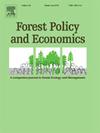Assessing homestead agroforestry-based livelihoods in Sivasagar District of Assam, India, using livelihood significance index (LSI)
IF 4
2区 农林科学
Q1 ECONOMICS
引用次数: 0
Abstract
This study evaluates the significance of homestead agroforestry (HAF) systems for rural livelihoods in Sivasagar District of Assam, India, using Livelihood Significance Index (LSI). The research integrates both quantitative and qualitative methods to offer a comprehensive analysis of how HAF systems contribute to rural livelihoods. The study reveals that the importance of various HAF plant species has undergone significant shifts over the past decade due to socio-economic changes, such as rising household expenses, market-oriented economic transitions, and urbanization. Among these species, Bambusa arundinacea has the highest livelihood significance, with an average LSI of 2.79, although this has decreased by 0.71 % from 2012 to 2022. Conversely, Tectona grandis, despite its low livelihood significance, has experienced a decadal increase in LSI of 20.5 %. This indicates that, while such species currently play a lesser role in community livelihoods, their importance is gradually increasing due to their economic benefits. The study also identifies several challenges, including the loss of traditional knowledge, the vulnerability of agroforestry systems to environmental changes, and difficulties in maintaining biodiversity amidst market pressures. To address these issues, the study advocates for sustainable agroforestry practices in the district that integrate both traditional and economically valuable species while improving market access for traditional products. In flood-prone villages like Afala, introducing flood-resistant species such as Mangifera indica, Artocarpus heterophyllus, and Bambusa arundinacea, along with training in value-added production, can enhance resilience and livelihood sustainability. Together, these approaches aim to cultivate a resilient and sustainable agroforestry landscape in Sivasagar District and beyond.
利用生计意义指数 (LSI) 评估印度阿萨姆邦锡瓦萨格尔地区以农林业为基础的家庭生计情况
本研究利用生计显著性指数(LSI)评估了印度阿萨姆邦Sivasagar地区农林业(HAF)系统对农村生计的重要性。该研究结合了定量和定性方法,对HAF系统如何促进农村生计进行了全面分析。研究表明,在过去十年中,由于家庭支出增加、市场经济转型和城市化等社会经济变化,各种HAF植物物种的重要性发生了显著变化。其中,黄竹(Bambusa arundinacea)的生计意义最高,平均LSI为2.79,但在2012 - 2022年间下降了0.71%。相反,尽管对生计的重要性不高,但大规模集成电路的十年增长率为20.5%。这表明,虽然这些物种目前在社区生计中发挥的作用较小,但由于它们的经济效益,它们的重要性正在逐渐增加。该研究还确定了若干挑战,包括传统知识的丧失、农林业系统对环境变化的脆弱性以及在市场压力下维持生物多样性的困难。为了解决这些问题,该研究提倡在该地区采用可持续的农林业做法,将传统和有经济价值的物种结合起来,同时改善传统产品的市场准入。在Afala这样的易受洪水影响的村庄,引进芒果(Mangifera indica)、石竹(Artocarpus heterophyllus)和竹(Bambusa arundinacea)等抗洪物种,并进行增值生产培训,可以增强抵御能力和生计的可持续性。总之,这些方法的目的是在Sivasagar区及其他地区培养一个有弹性和可持续的农林业景观。
本文章由计算机程序翻译,如有差异,请以英文原文为准。
求助全文
约1分钟内获得全文
求助全文
来源期刊

Forest Policy and Economics
农林科学-林学
CiteScore
9.00
自引率
7.50%
发文量
148
审稿时长
21.9 weeks
期刊介绍:
Forest Policy and Economics is a leading scientific journal that publishes peer-reviewed policy and economics research relating to forests, forested landscapes, forest-related industries, and other forest-relevant land uses. It also welcomes contributions from other social sciences and humanities perspectives that make clear theoretical, conceptual and methodological contributions to the existing state-of-the-art literature on forests and related land use systems. These disciplines include, but are not limited to, sociology, anthropology, human geography, history, jurisprudence, planning, development studies, and psychology research on forests. Forest Policy and Economics is global in scope and publishes multiple article types of high scientific standard. Acceptance for publication is subject to a double-blind peer-review process.
 求助内容:
求助内容: 应助结果提醒方式:
应助结果提醒方式:


